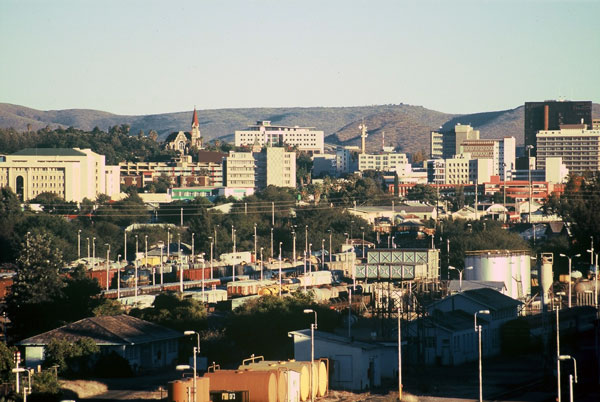- Australia and New Zealand
- East Asia and the Pacific
- Europe and Central Asia
- Albania
- Armenia
- Austria
- Azerbaijan
- Belarus
- Belgium
- Bosnia and Herzegovina
- Bulgaria
- Croatia
- Cyprus
- Czech Republic
- Denmark
- Estonia
- Finland
- France
- Georgia
- Germany
- Greece
- Hungary
- Iceland
- Ireland
- Italy
- Kazakhstan
- Kyrgyz Republic
- Latvia
- Liechtenstein
- Lithuania
- Luxembourg
- Malta
- Netherlands
- Norway
- Poland
- Portugal
- Romania
- Russian Federation
- Serbia
- Slovak Republic
- Slovenia
- Spain
- Sweden
- Switzerland
- Turkey
- Ukraine
- United Kingdom
- Uzbekistan
- Latin America and the Caribbean
Home > Countries > Sub-Saharan AfricaNamibia
Country Profile
 Source: Windhoek City Skyline, Wikimedia Commons
Source: Windhoek City Skyline, Wikimedia Commons
Of Namibia's 2.28 million people, 38 percent reside in urban areas. The urban population growth rate is 3 percent, while the total population growth rate is 1.8 percent (WDI 2010).
Despite high income inequality, 76 percent of Namibian households own the house they live in (Kalili et al 2008). However, the proportion of households living in informal settlements is increasing. In 1994, this percentage was 10 percent and by 2008 it had increased to 16 percent of total households and 28 percent for urban households (Sweeney-Bindels 2011). According to FinMarkTrust, 70 percent of the Namibian population cannot access collateralized home loan facilities.
Total mortgage loans outstanding for the whole financial sector represented 32 percent of GDP at the end of 2007, which is the highest in Africa (Bank of Namibia 2008). Three types of institutions provide housing finance in Namibia: Commercial Banks (Standard Bank, FNB, Bank Windhoek), the national government of Namibia (National Housing Enterprise, Agribank, Build Together Program) and NGOs (Shack Dwellers Federation). Commercial banks and the NHE finance middle to high-income households. The NHE also finances lower to middle-income households through the Shack Dwellers Federation and Build Together Program.
Commercial banks are the main providers of mortgages and pension-backed loans, and held 92 percent of all mortgage loans in 2007. The value of total mortgage loans as a ratio of total loans outstanding of commercial banks increased from 30.1 percent in 2001 to 52.3 percent in 2010 (Bank of Namibia 2011).The remaining mortgages were financed by the government through Agribank and the NHE (Kalili et al 2008).
Namibia's largest commercial banks—First National Bank (FNB)—finances up to 100 percent LTV (FNB 2011). Bank Windhoek requires a deposit from 10 percent to 20 percent of the purchase price, but will finance up to 100 percent at the bank's discretion (Bank Windhoek 2011).
The national government provides mortgage loans through subsidiaries such as Agribank, which grants loans for 80 percent of the valuation of the security (Agribank 2011), Build Together Program (BTP) and the National Housing Enterprise (NHE), both with a maximum LTV of 100 percent, including transfer and bond costs. Self-employed people are required to make a down-payment of 10 percent of the value of the property (NHE 2011). The NHE is the largest low-cost housing provider in Namibia (Kalili et al 2008).
Organizations such as the Shack Dwellers Federation of Namibia provide housing loans through the Twahangana Fund with 5 percent of the loan amount required as a down-payment.
Copyright © 2024. HOFINET. By using or accessing this website, you signify that you agree to the Terms of Use.
When using or citing any information displayed on this website or accompanying blog sites, you must provide a reference to HOFINET.